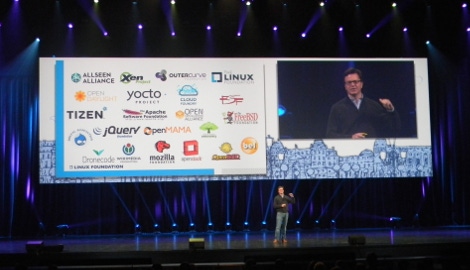Linux Foundation: Open Source is Eating the Software WorldLinux Foundation: Open Source is Eating the Software World
OpenStack Summit: Competent management of open source software is a new must for modern enterprises

PARIS - In every sector of the technology world there is now an open source project that is defining that particular technology. Software drives value in nearly every industry, and open source projects are where most of that value comes from.
That’s according to Jim Zemlin, executive director of the Linux Foundation and one of Monday’s keynote speakers at this week’s OpenStack summit in Paris – the first in Europe. “Open source is really eating the software world,” Zemlin said, adapting the famous phrase from a 2011 Wall Street Journal OpEd by venture capitalist Mark Andreessen, titled Software is eating the world.
There is a wholesale shift in the enterprise software world from using a little bit of open source code here and there to an 80-20 split, where 80 is the open source portion, he said. The reason for the shift is quite simple: software has become a way for an enterprise to add value, and open source is the best way to use a lot of software. “There is too much software being written for any organization to write that software on their own,” Zemlin explained.
Managing external R&D: a new necessity
The world’s top tech companies collectively spend tens of billions of dollars on R&D, and the bulk of their code comes from outside the organization, he said. This has created a new job category: managing external R&D. Companies like Google, HP and NEC, among others, all have people who are dedicated to managing open source software development.
Now that it has become the dominant form of enterprise software development, it’s important for each company to understand how to pick the right projects, how to do “social coding,” how to integrate open source code into your own environment, and how to contribute back to the central project. “Open source collaboration really requires a new set of skills,” Zemlin said.
Big users partner on method to open source madness
In addition to individual companies dedicating resources to managing their relationships with open source technologies and communities, there is an ongoing attempt to centralize systematic management of numerous open source technologies from the end user’s perspective. Called TODO (Talk Openly, Develop Openly), the project was started by a handful of high-tech heavyweights, including Google, Facebook, Twitter, Box, GitHub, and a few others, in September.
The companies created TODO to function as a clearinghouse of sorts for open source software. Details of its mission were fuzzy in its early days, but the founders said it would do things like create documentation for certain open source technologies to make them easier for others to deploy. A key part of TODO’s plan is to only get involved with open source technologies one of the members has used in production. Anyone looking at a software solution the organization lists will have the confidence that the solution has been used by a major company.
The next open source blockbuster
It is important to think about open source systematically, and having staff who are dedicated to that task is crucial if a company wants to be in the position to leverage the next big thing in open source, which today is OpenStack, Zimlin said. “OpenStack, without question, is a blockbuster,” he said.
Jonathan Bryce, executive director of the OpenStack Foundation, said the open source cloud architecture is popular because it speaks to the desire for choice in the IT shop and among the IT shop’s customers – the developers. It gives IT departments the freedom of choosing the hardware to deploy their clouds on, and through APIs it gives the developers flexibility in configuring their environments.
There is a lot of interest in OpenStack in Europe, if the summit’s attendance is any indication. Bryce said the foundation sold more tickets for the Paris summit than ever, admitting, however, that the city’s popularity probably had a lot to do with it. Thierry Carrez, the foundation’s director of engineering, said half of the attendees were European (compared to about 10 percent at the previous summit in Atlanta). Judging by a show of hands during the keynote, the overwhelming majority of attendees were at an OpenStack summit for the first time.
About the Author
You May Also Like







